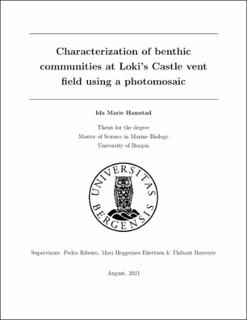| dc.description.abstract | Loki’s Castle was the first black smoker hydrothermal vent field to be discovered on the Arctic Mid-Ocean Ridge (AMOR), and is known to host a specialized and highly endemic fauna. Despite being studied since its discovery in 2008 there are still knowledge gaps, especially regarding the diversity and spatial distribution of the faunal community. The increasing interest in opening areas at the AMOR to deep sea mining makes it crucial to gather baseline data from the sites that could be affected, including Loki’s Castle. The purpose of this thesis was to characterize the abundance, diversity and spatial distribution of the benthic megafauna community at Loki’s Castle and to investigate the influence of abiotic factors on this community. To achieve this, an ortophotomosaic created from seafloor images of the area was used to annotate and quantify all visible fauna. These observations were analyzed together with pre-existing data of abiotic parameters (temperature and heat flux) and topographic variables (slope, aspect and roughness) from the vent field, using a multivariate analytical framework. A total of 14743 observations were recorded, and 20 morphospecies belonging to eight different phyla were identified. There were statistically significant differences between diffuse venting areas, focused venting areas and peripheral areas in density, diversity and morphospecies distribution. The diffuse venting site called the Barite field supports a diverse and dense community of organisms. Some of these, such as the tubeworm Sclerolinum contortum, are dependent on symbiosis with chemosynthetic bacteria, while others are likely influenced by a facilitating cascade where S. contortum is the primary foundation species. Temperature and slope were found to significantly influence the spatial distribution of most of the prominent morphospecies, total abundance and species richness. However, most of the species distributions could not be explained by temperature and slope, and it is likely that other biological and abiotic factors such as food availability, competition, predation, substrate and hydrothermal fluid composition also contribute to the observed patterns. This hypothesis should be investigated in future experimental studies. A seabed mining event at or near Loki’s Castle could change the benthic megafaunal community through elimination of vital habitat and alteration of the hydrothermal circulation from vents. This thesis provides baseline knowledge that can be useful in assessing how the benthic megafaunal community will be impacted by a possible future mining event. | |
